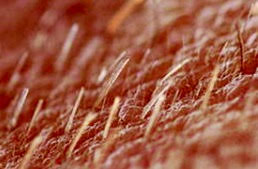Blog
-

Wow, That’s Some Ear Hair!
 24 May , 2016
24 May , 2016
This article is not about hair cells and cilia of the cochlea, where acoustic energy is translated into electrical energy. It’s about ear hair. You know, the hairy growth that one sometimes notices in a person’s ears, but almost never mentions—as if talking about it were taboo. There are many jokes made about men having little or no hair on their head, but when is the last time you heard anyone say, “Wow, you have really hairy ears,” unless they have progressed beyond their third martini?
What does ear hair have to do with earwax? It can have an impact on preventing earwax from being released naturally from the ear canal. This post is not intended to offer suggestions on how to comment gracefully (if even possible) on one’s ear hairs, and it may not be one of the most pleasant topics. However, it is a subject of interest for clinicians.
From an histology viewpoint, the ear canal skin has three appendages/derivatives: 1) Ceruminous glands; 2) Sebaceous glands, and 3) Hairs. My last blog post concentrated on the ceruminous and sebaceous glands in the ear canal skin, which empty into the outer portion of the ear canal, through hair follicles. This post focuses on the hair, arising from follicular cartilage of the outer cartilaginous portion of the ear canal or from the tragus, antitragus, or helix portions of the auricle/pinna.
Two Types of Ear HairVellus hairs.
Vellus hairs are tiny, short, thin, and almost invisible (see image), growing in most places on the human body. At the ear, they are present in the very outer portion of the ear canal (in the outer cartilaginous area or on the pinna itself). The density varies among individuals. When short, it is often referred to as “peach fuzz.” According to Marks and Miller, the strands are usually short (less than 2 mm), and the follicle is not connected to a sebaceous gland. Marks and Miller also identify other cases of irregular vellus hair growth, with hairs growing to as long as 2-4 cm.
Vellus hair is mostly non-pigmented. However, during and after puberty, dihydrotestosterone (DHT) present in the body causes vellus hairs on the arms, legs, faces, and in other parts of the body to grow thicker and darker, into “terminal” hair—to a greater extent in men than women with aging, the normal growth cycles of hair (growth, resting, and falling out phases) get out of whack, and as a result, some hairs grow longer before they are shed.
Tragi hairsTragi hairs are larger, thicker and stiffer terminal hairs. They take their name from Latin (tragos = “goat”) with reference to the characteristic tuft of hair that is often present, likened to a goat’s beard. These can be prominent in the outer portion of the ear canal, on the tragus, antitragus, and in extreme cases, over the helix.Tragi hairs can be numerous in some people and also very prominent. This condition is more often found in men than women. In some extreme cases, the ear hair can be quite long, recorded as being 5.2 inches by the Guinness World Records in 2003 for Radhakant Baijpai. Since then, the 64-year-old (in 2015) grocer’s ear hair has continued to grow to almost 10 inches long.
Ear hair is generally identified as the terminal hair developing from the follicles inside the ear canal. However, in its broader sense, ear hair may include the fine vellus hair covering much of the ear (particularly at the prominent parts of the anterior ear), as well as the terminal, or tragi hair.
Hair growth within the ear canal itself is limited to the cartilaginous ear canal: roughly the outer one-third of the ear canal. The inner two-thirds of the ear canal, called the bony ear canal, does not have sufficient dermis and hypodermis underlying the epidermis to support the hair root of hair follicles. In contrast, hair growth within the outer portion of the ear canal seems to increase and become stiffer as men age (along with an increase in nasal hair growth).
Ear Hair Function
Ear hair serves a protective function by filtering dust from the air and also acts to impede the entry of insects and debris. It has been reported that heavy growth may prevent hearing aids from making a good seal. Heavy tragi hair can sometimes create problems when making ear impressions, and often “barbering” is required because certain ear impression materials might allow the hairs to become embedded into the ear impression, potentially causing discomfort when removing the ear impression with hair attached.
Similar thick hairs are often found lining the outer portion of the ear canal and can interfere with the normal outward migration of wax and debris, leading to an accumulation in the ear canal. In rarer cases, tragi hairs can be found in the tragus, antitragus, and helix portions of the ear canal air (throughout the auricle), and can cover the ear. This condition is reserved for males only and is inherited as a Y-linked trait.
Source: Blog posting Written By Wayne J. Staab, PhD
Image credit: Hearing Health Matters
(Vellus hairs, are short and almost invisible, growing in most places on the body.)





























































































































































































































































































































































































































































































































































































